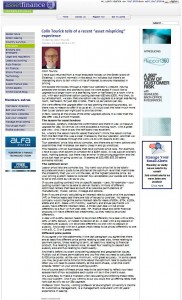The following article by Colin Tourick was published in Asset Finance International on 11 June 2012. The full text is reproduced below.
I have just returned from a most enjoyable holiday on the Greek island of Skiathos. I wouldn’t normally write about my holidays but there’s an interesting story to tell which will be of interest to anyone interested in pricing.
We booked the holiday through a major tour operator’s website. Having selected the holiday and started to book we were asked if would like to upgrade to a larger room or a sea-facing room or half board or a room with a cot, with each additional option costing between £80 and £300. And then, to our amazement, we saw that one option was to upgrade to a larger sea-facing room, half board, for just 28p in total. That’s 1p per person per day.
We were offered the upgrade after we had starting the booking process, so there was no reason to offer it to us at all. It would cost the hotel much more than 1p per person per night just to provide dinner.
In fact, looking at the prices of the other upgrade options it is clear that the 28p offer was a simple mistake.
We booked, carefully checked the confirmation and there it was: a massive upgrade for 28p. On arrival we were allocated a nice big room, with a great sea view. And I have to say the half board was excellent.
So, where’s the lesson here for asset financiers? I think the lesson comes from the fact that this was a clear mistake by the tour operator, and that we see similar mistakes through the work we do with lessors every day.
Tour operators’ price lists are so complex, and there are so many options and possibilities that mistakes can easily creep in and go unnoticed.
This happens with all businesses that have complex price lists. For example, I have a copy of an advert on Amazon for a $23m book. It was just an ordinary book, nothing special, but there was an error in the pricing algorithm and the price just kept on going up and up. It peaked at $23,698,655.93 before someone noticed.
Lessor price lists are complex too. You want your price list to be totally accurate and every quote to be pitched at the optimum level that maximises the probability that you will win the deal, at the highest possible price. So your pricing system needs to consider how acceptable your quotes are likely to be to the client as well as to you.
If you are quoting contract hire on specific assets – cars, for example – your quoting system has to be able to deliver literally millions of different optimised rentals that take account of all possible permutations of manufacturer, model, period, mileage and options.
Even if you are simply calculating an interest rate to quote on an HP or finance lease deal there are lots of issues to consider. No leasing company would charge the same interest rate for deals of £20k, £70k, £120k, £250k and £1m. Deals with monthly, quarterly and annual payments will usually have different interest rates. A 3 year deal will be priced differently to a 4 or 5 year deal. HP, finance lease and other financial products will have different tax treatments, so they need to be priced differently. A deal with a 20% balloon needs to be priced differently to a deal with a 30%, 40% or 50% balloon, or indeed no balloon at all. A deal with a big deposit or manufacturer subsidy will be priced differently to one with no deposit or subsidy. And a deal with an A grade credit needs to be priced differently to one with a B, C, D or E grade credit.
If you agree with the statements in the last paragraph you agree that there are at least 5 different price points relating to deal size, 3 relating to payment period, 3 relating to term, at least two relating to financial product, 5 relating to balloon size, at least 4 relating to deposit and subsidy size and 5 relating to credit quality. And that’s before you start considering seasonal and geographical issues. Multiply out all those permutations and you find that you need to calculate 9,000 price points, at the very minimum, with great accuracy. In some cases you may be given some time to think about the optimum rate to quote but often you will need to quote instantly at the point of sale, when the client presses Enter on your online quoting system.
And of course each of these prices need to be optimised to reflect your best assessment of how acceptable each quote will be in the client’s eyes.
It’s quite easy to make a mistake when calculating and entering these rates into your system. And if you were to do so you could end up offering rates that look just as silly as our 28p upgrade.


